Chairman NCJG
Krommenie
URL: http://www.judo4all.eu/
Revised edition December 2007
It is not allowed to copy and/or publish this publication, without permission of the author
© 2004-2006 Ben van der Eng
|
Ben van der Eng Chairman NCJG Krommenie URL: http://www.judo4all.eu/ |
Reprinted with the permission of the author Revised edition December 2007 It is not allowed to copy and/or publish this publication, without permission of the author © 2004-2006 Ben van der Eng |
ForwardWhether judo in all its aspects is the right sport for people with Down syndrome is a question that is difficult to answer. Certainly if we want to see this question from all point of views. There's a risk factor that can't be ignored even the fact that important rule adaptations are made in order to avoid injuries1. Judo is often declared as a combat game and opposites of the sport proclaim that intellectual disabled people should not to be encourage to 'fight'. Even insiders of the sport thought at the first introduction, that ID-athletes would not know the difference between sport enthusiasm and aggression. The athletes proved them all wrong by proving their ability in a sport many people still misunderstand. They can't ignore the fact that in this group the emancipation and progression is enormous. Judo provides enormous amount of fun and possibilities to all people including those who need extra attention as judoka's with Down syndrome. This bring us to the question, who decide whether people with Down syndrome can practice the sport of judo??? Parents, (judo) organisations, judo trainers or the person self?? Well in each case it will be different, in my point of view as judo teacher our goal must be to help persons with a disability. We can offer them a fair opportunity to develop and demonstrate their skills and talents through judo all the way. On the other hand by accepting people with Down syndrome we have the responsibility for the wellbeing of these athletes during training and competition. In order to do this rightfully we must understand the needs of these students. Sure every human being is unique, though no one can escape specific characteristics with which we are born or taught. In this issue I tried to characteristic judoka's with Down syndrome focused on the atlanto-axial instability. It seems to me that this relative higher injury risk by people with Down syndrome must by placed in the right perspective. I also took the liberty to add my point of view according precautionary measures. Otagai ni rei
Ben van der Eng
Chairman of the Dutch National Disabled Commission Judo May 2004 Syndrome DefinitionWhen symptoms and/or characteristics are shared by different people in a recognizable pattern, it constitutes a syndrome. Definition of Down SyndromeCongentital (Born) disorder with characteristic (face) remarks and a light till serious mental disability. Down syndrome is the most common and readily identifiable chromosomal condition associated with mental retardation. It is caused by a chromosomal abnormality: for some unexplained reason, an accident in cell development results in 47 instead of the usual 46 chromosomes. This extra chromosome changes the orderly development of the body and brain IncidenceApproximately 200 children with Down syndrome are born in the Netherlands each year, or about 1 in every 800 to 1,000 live births. Although parents of any age may have child with Down syndrome, the incidence is higher for women over 35. Most common forms of the syndrome do not usually occur more than once in a family. CharacteristicsThere are over 50 clinical signs of Down syndrome, but it is rare to find all or even most of them in one person. Some common characteristics include:
Individuals with Down syndrome are usually smaller than their non-disabled peers, and their physical as well as intellectual development is slower. Besides having a distinct physical appearance, children with Down syndrome frequently have specific health-related problems. A lowered resistance to infection makes these children more prone to respiratory problems. Visual problems such as crossed eyes and far- or nearsightedness are higher in those with Down syndrome, as are mild to moderate hearing loss and speech difficulty. Approximately one third of babies born with Down syndrome have heart defects, most of which are now successfully correctable. Some individuals are born with gastrointestinal tract problems that can be surgically corrected. Atlanto-axial Dislocation: Participation by Individuals with Down syndrome Who Have Atlanto-axial Instability(article 1, Section L.7.f. Special Olympics) 
In light of medical research indicating that up to 15% of individuals with Down syndrome have Atlanto-axial instability, exposing them to possible injury if they participate in activities that hyper-extend or hyper-flex the neck or upper spine, all Accredited Programs must take the following precautions before permitting athletes with Down syndrome to participate in certain physical activities. The S.O. organization always has indicated AAI as a serious contra indication for risk sports for DS Athletes. Rightly or over done? Let's look at the facts and if we have to adjust things or make precautionary measures. What is atlanto-axial instability?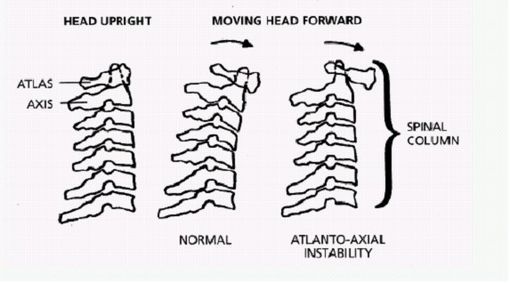
In people with Down's syndrome the ligaments which normally hold the joints stable can be very slack. This can lead to an unusually wide range of movement at some joints much greater than in the general population. As well as affecting the ordinary limb joints this can affect the stability of one of the joints in the neck – the atlanto-axial joint. This joint is the highest joint in the spinal column and it lies just at the base of the skull. There is movement at this joint whenever you nod or shake your head (see diagrams). The lower diagram shows in the middle picture that when the atlas and axis vertebrae are firmly bound to each other both move together when the neck bends forward. The diagram on the right shows the situation when the ligaments binding the joint are slack. Here the atlas moves forward but fails to carry the axis within some people with Down's syndrome in addition to a slack ligament the actual bones of the atlanto-axial joint may be poorly developed. Theoretically these differences could make the joint more likely to dislocate than in people without Down's syndrome. Medical contra indications for athletes:About this issue there is and will be always discussion in the medical world. Roughly there are two opinions:
The SO does not plan to remove its requirement that all athletes with DS receive neck X-rays. Paediatricians will therefore continue to be called on to order these tests. The information here can be used to interpret the results for family members ...." In this matter it is reasonable to conclude that lateral neck X-rays are of potential but unproven value in detecting patients at risk for developing spinal cord injury during sports participation. It seems that identification of those patients who already have or who later have complaints or physical findings consistent with symptomatic spinal cord injury is a greater priority than obtaining X-rays. Recognition of these symptomatic patients is challenging and requires frequent interval histories and physical exams, including evaluations before participation in sports, preferably by physicians who have cared for these patients longitudinally. Their coaches must learn the symptoms of AAI that indicate the need to seek immediate medical care3. Symptoms of injury of the nerve-system can be:
Article 4 JBN RegulationsAdditional prohibited actions:Sub: 2 With both 'tachi-waza' as 'ne-waza'The referee ensures that the neck is not strangled in such a way that risks for injury exists!!!! They shall observe with extra attention the following techniques: Ne-waza: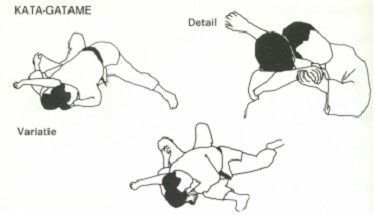
Hon-gesa-gateme Kata-gateme (Additional prohibited actions in my point of view) Makura-gesa-gateme Kuzure-Tate-Shiho-Gatame (Additional prohibited actions in my point of view) 
Summary:Article 4 subs 2 deserve extra attention by people with met Down syndrome during the competition. The referees have to make sure that techniques with these skills shall be preformed correctly by the judoka's. Hon-gesa-gateme or any other grips were the hands are strangled or the fingers hooked while there's no arm included is not an option. In my opinion the referee has to interfere by mate. In this matter it is also the responsibility of the teacher or coach. It seems to me that during training such actions are dealt with and point out to students as not done. Tachi-waza
Regulations only deal briefly about grip around the neck during tachi-waza. In my opinion I believe it's reasonable to teach throws like Kubi-nage and Koshi-guruma only to judokas who understand the basic principles of the hip throw Surely not a throw for beginners 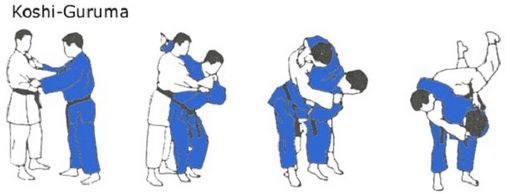
It's better to start with Uki-goshi 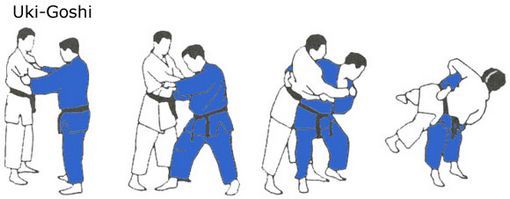
Responsibility and common sense
There are more techniques that can cause serious neck injuries. For instance Morote-gari. Dealt with in regulations as prohibited action, I'm unpleasant surprised to see in our competition suddenly O-uchi-gari while one leg is already lifted by hand. In my opinion even more dangerous than Morote-gari, due the lack of balance tori has less control over uke. It seems to me that insight, common sense and responsibility of the trainer or coach is doubtful. I would pleat not to teach this kind of techniques to judoka's, especially those who do not understand the difference between training and competition. Overall I think this can occur by judoka's level 3 till 5. |
Judoka's
Dik Koene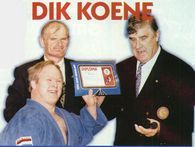
Here receiving his 1st Dan from the legendaries Anton Geesink after performing his Naga-no-kata with Ageeth Bakker as uke. Dik started his judocareer in 1974 by Judo-club Prisma in Amsterdam and is still active. He trains 3 times a week, of course not as intensive as in his early day's. Still which main stream judoka at the age of 60 would be able to do this? After more than 30 years of judo Dik has seen it all, compete in to almost every judo4all tournament in Europe and was the first 2nd Dan with Down syndrome in the world. Sander Munnik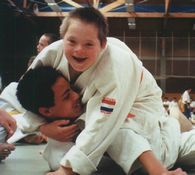
At the age of 10 years (above) and now at 24 years (below) and 1e Kyu (brown belt) and aiming for 1st DAN 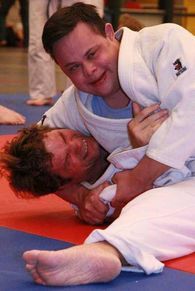
Thomas Schepen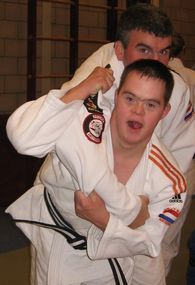
My name is Thomas Schepen I told a short story to Ben who translate into English. 4 March: Yes I succeed to earn my black belt, I did a great exam with Tycho my trainer. I hope I'm going to China for the world games because I want to be number one there. Also was competing in Sweden, Italy, Germany, Belgium and lot of other countries with an airplane, yes, with my friends. Yes, they must not grab my head, once a boy did and my neck was painful for a long time. I need treatment from Ivor (physiotherapist) now I learn new skills from Tycho. Yes, also surrender when it hurts. My daddy taken the photos, he's very proud of me. My granny was there to see me. Bye Thomas 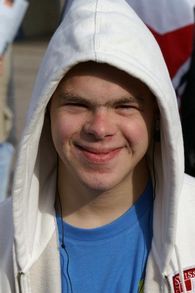
Thomas Schepen is 22 years old and started judo by age of 4 at the judo club De Schakel in Amstelveen; at 16 he become a student at the Judo Club Prisma in Amsterdam. He performed one of the best Naga-no-kata during the main stream DAN exams were he becomes the youngest 1 Dan with Down syndrome in the history of the JBN. Jasper Duinisveld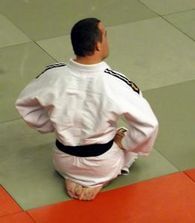
When looking in the mirror he will come to the conclusion that his technique is not at all bad. More than that: 'he is a talent', his trainer and sparring partner IJsbrand Schipperus says about his pupil. 30 year-old Jasper, who has Down syndrome, is going to achieve a unique feat on Saturday 20th May. Then, instead of the mirror, he is going to show the examiners how clever his throws are. If things go according to plan, he will get his unique 2nd Dan. A member of the Dutch Judo Association explains that Jasper can really achieve something exceptional. 'This does not happen very often, but whether Jasper is the first we don't know, because our administration does not distinguish between handicapped and non-handicapped people. The examiners are decided however: 'Such a talent does not occur very often.' Besides being a talented judo player, Jasper is a person who asks for a lot of attention and is a very lovely person according to his trainer at the Goederaad sportschool in Bodengraven. I'm confident that things will turn out all right. The committee told me they've seen worse candidates pass.' |